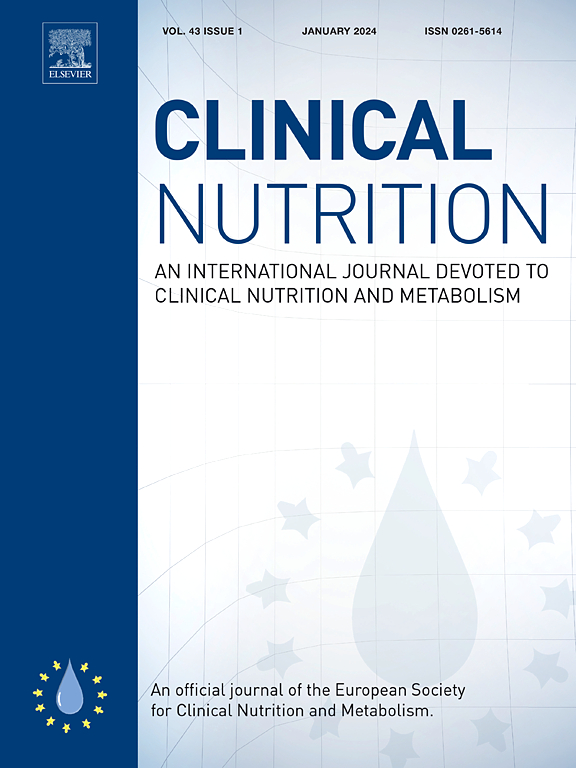Standard continuous feeding versus intermittent feeding among mechanically ventilated patients in intensive care: A systematic review and meta-analysis of randomized controlled trials
IF 6.6
2区 医学
Q1 NUTRITION & DIETETICS
引用次数: 0
Abstract
Background
Previous meta-analyses on the mode of enteral nutrition in intensive care unit (ICU) have not explored whether the standard practice of continuous enteral feeding is superior to intermittent or bolus feeding among mechanically ventilated patients. Large feed volumes maybe one of the barriers for the use of intermittent feeding. However, intermittent feeding when routinely paired with right lateral tilt positioning may be better tolerated. Aligning feeding-fasting periods with circadian patterns may also be beneficial during critical illness in relation to important patient-centered clinical outcomes.
Objectives
This systematic review and meta-analysis will summarize the current state of evidence from all randomized controlled trials (RCTs) comparing standard continuous gastric feeding and intermittent gastric feeding (with or without right lateral tilt positioning) among critically ill adult patients receiving mechanical ventilation in ICU.
Methods
A systematic search was conducted in MEDLINE, EMBASE and CENTRAL for relevant RCTs published in the English language until September 2024. The primary outcome was all cause hospital mortality, expressed as pooled risk ratio (RR) for the standard continuous feeding relative to intermittent feeding. Key secondary outcomes were ICU length of stay, gut intolerance (vomiting and diarrhoea) and pneumonia.
Results
Sixteen studies were identified for full text review out of a total of 678 records screened. Eight RCTs enrolling a total of 993 patients were included in this meta-analysis. There was a substantial heterogeneity in outcomes selection, definitions, and reporting among these RCTs. Aggregate effect size for the primary outcome was RR 0.97 (95 % confidence interval 0.72–1.32, I2 = 9 %) for standard continuous feeding versus intermittent feeding. There were no between-group differences for any of the other secondary outcomes. Of all the included RCTs, the point estimate for all-cause mortality was least favourable (RR 1.55, 95 % CI 0.82 to 2.93) for the standard continuous feeding in the RCT that compared it against intermittent postural feeding.
Conclusions
Overall, our meta-analysis did not detect any clinically relevant differences in important clinical outcomes between the two groups. Future RCTs should prioritise clinically meaningful, patient-centred outcomes such as mortality or ventilator-free days as primary endpoints.
PROSPERO registration number
CRD42024591074.
重症监护机械通气患者的标准连续喂养与间歇喂养:随机对照试验的系统回顾和荟萃分析
背景先前关于重症监护病房(ICU)肠内营养模式的荟萃分析并没有探讨在机械通气患者中,持续肠内喂养的标准做法是否优于间歇或大剂量喂养。大的进料量可能是使用间歇进料的障碍之一。然而,间歇喂养时,常规配对右侧倾斜体位可能更好的耐受。在危重疾病期间,与以患者为中心的重要临床结果相关的昼夜节律模式调整喂养-禁食时间也可能是有益的。目的:本系统综述和荟萃分析将总结来自所有随机对照试验(rct)的证据现状,这些试验比较了在ICU接受机械通气的危重成人患者中标准连续胃喂养和间歇胃喂养(有或没有右侧倾斜定位)的证据。方法在MEDLINE、EMBASE和CENTRAL中系统检索截至2024年9月已发表的相关英文rct。主要结局是全因住院死亡率,用标准连续喂养相对于间歇喂养的综合风险比(RR)表示。关键的次要结局是ICU住院时间、肠道不耐受(呕吐和腹泻)和肺炎。结果从筛选的678篇文献中筛选出16篇文献进行全文综述。本荟萃分析纳入了8项随机对照试验,共纳入993例患者。在这些随机对照试验中,结果选择、定义和报告存在很大的异质性。标准连续喂养与间歇喂养的主要结局的总效应大小为RR 0.97(95%可信区间0.72-1.32,I2 = 9%)。其他次要结果没有组间差异。在所有纳入的RCT中,与间歇性体位喂养相比,标准连续喂养的全因死亡率的点估计最不有利(RR 1.55, 95% CI 0.82至2.93)。总的来说,我们的荟萃分析未发现两组之间重要临床结局有任何临床相关差异。未来的随机对照试验应优先考虑有临床意义的、以患者为中心的结局,如死亡率或无呼吸机天数作为主要终点。普洛斯彼罗注册号crd42024591074。
本文章由计算机程序翻译,如有差异,请以英文原文为准。
求助全文
约1分钟内获得全文
求助全文
来源期刊

Clinical nutrition
医学-营养学
CiteScore
14.10
自引率
6.30%
发文量
356
审稿时长
28 days
期刊介绍:
Clinical Nutrition, the official journal of ESPEN, The European Society for Clinical Nutrition and Metabolism, is an international journal providing essential scientific information on nutritional and metabolic care and the relationship between nutrition and disease both in the setting of basic science and clinical practice. Published bi-monthly, each issue combines original articles and reviews providing an invaluable reference for any specialist concerned with these fields.
 求助内容:
求助内容: 应助结果提醒方式:
应助结果提醒方式:


